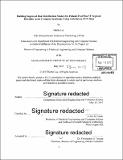| dc.contributor.advisor | Collin M. Stultz. | en_US |
| dc.contributor.author | Lee, Harlin. | en_US |
| dc.contributor.other | Massachusetts Institute of Technology. Department of Electrical Engineering and Computer Science. | en_US |
| dc.date.accessioned | 2018-01-12T21:15:55Z | |
| dc.date.available | 2018-01-12T21:15:55Z | |
| dc.date.copyright | 2017 | en_US |
| dc.date.issued | 2017 | en_US |
| dc.identifier.uri | http://hdl.handle.net/1721.1/113180 | en_US |
| dc.description | Thesis: M. Eng., Massachusetts Institute of Technology, Department of Electrical Engineering and Computer Science, 2017 | en_US |
| dc.description | Cataloged from PDF version of thesis. | en_US |
| dc.description | Includes bibliographical references (pages 27-28). | en_US |
| dc.description.abstract | Accurately and promptly assessing a patient's risk of future adverse cardiovascular events is crucial to the care of patients with non-ST-segment elevation acute coronary syndrome (NSTE-ACS). Inpatient telemetry data are collected for patients post-NSTE-ACS as part of the standard protocol, but current practices do not take advantage of those data to improve the assessment of the patient's long-term risk. Furthermore, previously developed risk metrics that use long-term electrocardiogram (ECG) data focus on instantaneous heart rates and do not fully exploit the ECG morphology, including the clinically important ST-segment morphology. Using a dataset of more than 4400 patients with NSTE-ACS, we developed a logistic regression model that uses the age of the patient and the mean and variance of the level of ST-segment over a 24-hour period, and found that it is highly predictive of one-year cardiovascular death, outperforming other models based on existing ECG-based risk metrics (AUC: 0.761; p<0.001). Uni- and multivariate analysis shows that the model provides information for risk stratification of NSTE-ACS patients beyond what is provided by risk metrics routinely used in clinical settings, such as TIMI risk score, B-type natriuretic peptide, and left ventricular ejection fraction (adjusted hazard ratio for one-year death (95% Cl): 5.25 (1.42, 21.2)). This model is unique in its simplicity, as it relies on simple logistic regression with only three features, which are automatically computed and easily interpreted. Our findings highlight the prognostic value of subtle ST-segment deviations that fall below the resolution of the human eye. | en_US |
| dc.description.statementofresponsibility | by Harlin Lee. | en_US |
| dc.format.extent | 44 pages | en_US |
| dc.language.iso | eng | en_US |
| dc.publisher | Massachusetts Institute of Technology | en_US |
| dc.rights | MIT theses are protected by copyright. They may be viewed, downloaded, or printed from this source but further reproduction or distribution in any format is prohibited without written permission. | en_US |
| dc.rights.uri | http://dspace.mit.edu/handle/1721.1/7582 | en_US |
| dc.subject | Electrical Engineering and Computer Science. | en_US |
| dc.title | Building improved risk stratification models for patients post non ST-segment elevation acute coronary syndrome using ambulatory ECG data | en_US |
| dc.type | Thesis | en_US |
| dc.description.degree | M. Eng. | en_US |
| dc.contributor.department | Massachusetts Institute of Technology. Department of Electrical Engineering and Computer Science | en_US |
| dc.identifier.oclc | 1017490952 | en_US |
| dc.description.collection | M.Eng. Massachusetts Institute of Technology, Department of Electrical Engineering and Computer Science | en_US |
| dspace.imported | 2019-06-17T20:35:34Z | en_US |
